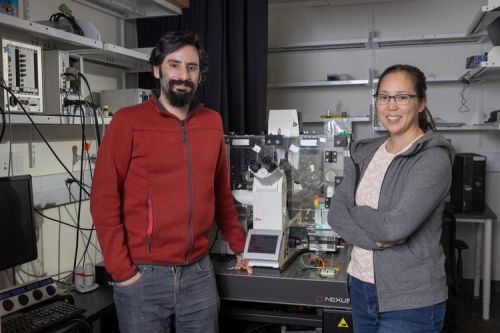
Daniel Cohen and Michelle Chan. Photo by Kevin Birch
Catherine Zandonella, Office of the Dean for Research
May 5, 2023
An MAE project with the potential to open new avenues in science and engineering — mapping the body's "electrome" — has been selected for funding through Princeton’s Eric and Wendy Schmidt Transformative Technology Fund.
Co-led by Daniel Cohen, assistant professor of mechanical and aerospace engineering, and Michelle Chan, assistant professor of molecular biology and genomics, this project is one of three Schmidt-funded projects this year, according to a recent announcement.
“These are early-stage projects with tremendous potential to enable scientific discoveries and technological innovations that can benefit society at large,” said Dean for Research Pablo Debenedetti, the Class of 1950 Professor in Engineering and Applied Science and professor of chemical and biological engineering. “These projects have transformative potential but are so groundbreaking that they carry some risk, and we are grateful to Eric and Wendy Schmidt for their generosity and their vision in recognizing the importance of funding this stage of research.”
The fund was created in 2009 through a gift from Eric and Wendy Schmidt. Eric Schmidt is the former Chief Executive Officer of Google and former Executive Chairman of Alphabet Inc., Google’s parent company. Wendy Schmidt is a businesswoman and philanthropist. Eric Schmidt earned his bachelor’s degree in electrical engineering from Princeton in 1976 and served as a Princeton Trustee from 2004 to 2008.
Electricity is foundational to life, from the electrical regulation of our heartbeats to natural electric currents that help our injuries heal. Although clinicians have had some success using electrical stimulation to treat brain tumors and improve organ transplantation, researchers lack a clear mechanistic understanding of how electrical inputs translate to the body’s responses.
To enhance this understanding, this project aims to create comprehensive maps of the relationships between electrical inputs and resulting cellular behaviors. The team will create a new, high-throughput platform for conducting experiments to determine how electrical stimulation leads to associated responses, from the genes that become activated to behaviors such as cell migration and proliferation.
These maps of living organisms’ electrical landscape, or electrome, will form an atlas that researchers can use to predict how applying electrical stimulation can cause a corresponding change in a given cell type. The team brings together expertise in bioelectric interfaces and genomics to answer questions such as: What is the range of biological responses that electrical stimulation can target? Which types of electrical inputs give the optimal biological response? The answers could provide fresh perspectives in the treatment of a range of diseases.